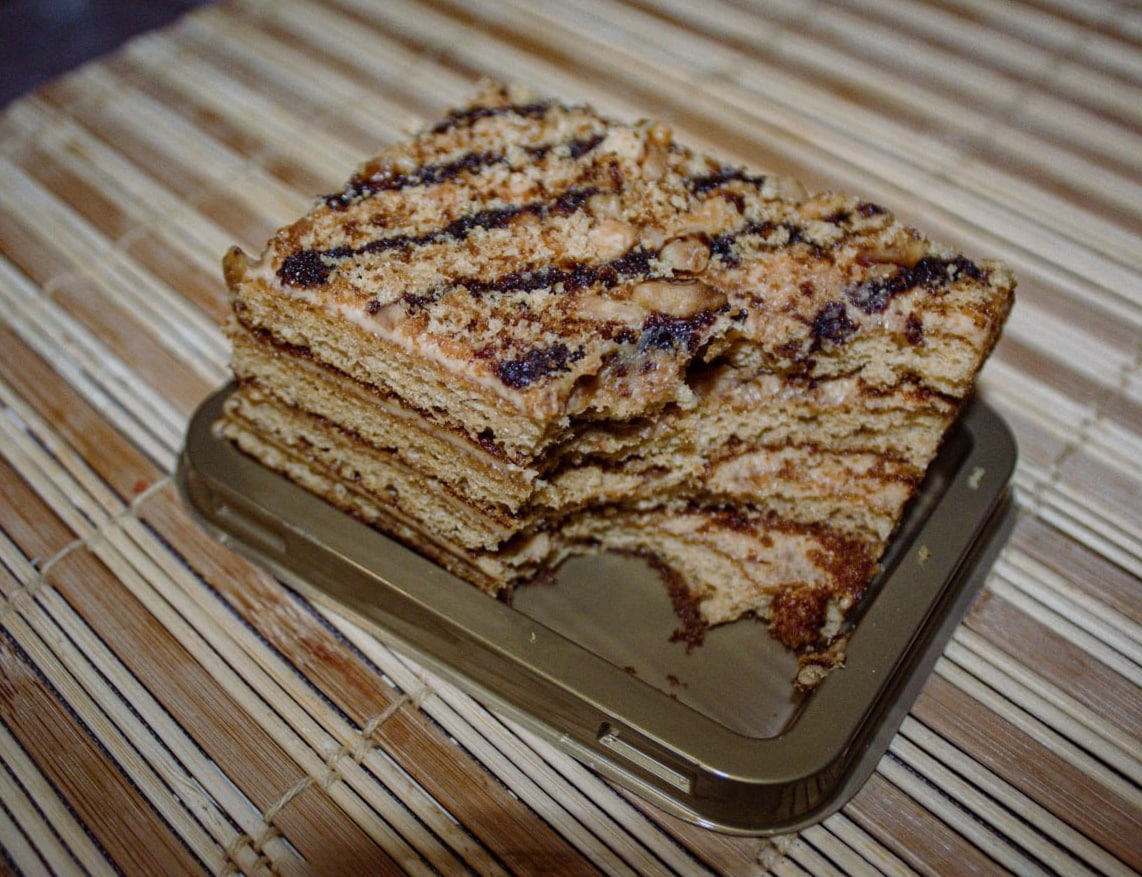Medovik on:
[Wikipedia]
[Google]
[Amazon]
Medovik (russian: медови́к (medovik), ukr, медівник (medivnyk), from мёд/мед — 'honey') is a layer cake popular in countries of the former Soviet Union. The identifying ingredients are
 Similar to Medovik desserts are popular also in other Eastern and Central European countries. There is the Czech Medovnik and the Polish Miodownik. In Bulgaria Medovik is mostly known under the name French Village Cake. Ukrainian medivnyk is cooked without the cream.
Similar to Medovik desserts are popular also in other Eastern and Central European countries. There is the Czech Medovnik and the Polish Miodownik. In Bulgaria Medovik is mostly known under the name French Village Cake. Ukrainian medivnyk is cooked without the cream.
honey
Honey is a sweet and viscous substance made by several bees, the best-known of which are honey bees. Honey is made and stored to nourish bee colonies. Bees produce honey by gathering and then refining the sugary secretions of plants (primar ...
and smetana (sour cream) or condensed milk
Condensed milk is cow's milk from which water has been removed (roughly 60% of it). It is most often found with sugar added, in the form of ''sweetened condensed milk'' (SCM), to the extent that the terms "condensed milk" and "sweetened condens ...
.
It is a dessert which is known for its lengthy preparation time. It consists of layers of sponge cake
Sponge cake is a light cake made with egg whites, flour and sugar, sometimes leavened with baking powder. Some sponge cakes do not contain egg yolks, like angel food cake, but most of them do. Sponge cakes, leavened with beaten eggs, originated ...
with a cream filling and is often covered with nuts or crumbs made from leftover cake. While the thin layers harden shortly after coming out of the oven, the moisture of the filling softens it again over time. There are many recipes and variations of this cake, but, the main ingredient is honey, giving it the characteristic taste and flavor.
Origins
According to Russian tradition, the cake was created in the 19th century in theRussian Empire
The Russian Empire was an empire and the final period of the Russian monarchy from 1721 to 1917, ruling across large parts of Eurasia. It succeeded the Tsardom of Russia following the Treaty of Nystad, which ended the Great Northern War. ...
by a young chef who sought to impress Empress Elizabeth Alexeievna
Princess Louise of Baden (13/24 January 1779 – 4/16 May 1826) was, later known as Elizabeth Alexeievna ( rus, Елизавета Алексеевна), the Empress of Russia during her marriage with Emperor Alexander I.
Princess of Baden
Eliz ...
, wife of Alexander I Alexander I may refer to:
* Alexander I of Macedon, king of Macedon 495–454 BC
* Alexander I of Epirus (370–331 BC), king of Epirus
* Pope Alexander I (died 115), early bishop of Rome
* Pope Alexander I of Alexandria (died 320s), patriarch of ...
. Empress Elizabeth could not stand honey, and any dish made with it drove her mad. One day, however, a young new confectioner in the Imperial kitchen did not know the empress's dislike, and he baked a new cake with honey and thick sour cream. Surprisingly, and unaware of the honey content, Empress Elizabeth immediately fell in love with it.
Despite this legend, traditional Russian cookbooks make "little or no mention" of medovik. Medovik gained its intense popularity during the Soviet
The Soviet Union,. officially the Union of Soviet Socialist Republics. (USSR),. was a List of former transcontinental countries#Since 1700, transcontinental country that spanned much of Eurasia from 1922 to 1991. A flagship communist state, ...
era. Today, there are numerous variations of medovik: with condensed milk, buttercream or custard
Custard is a variety of culinary preparations based on sweetened milk, cheese, or cream cooked with egg or egg yolk to thicken it, and sometimes also flour, corn starch, or gelatin. Depending on the recipe, custard may vary in consistency fro ...
.
Similar recipes
 Similar to Medovik desserts are popular also in other Eastern and Central European countries. There is the Czech Medovnik and the Polish Miodownik. In Bulgaria Medovik is mostly known under the name French Village Cake. Ukrainian medivnyk is cooked without the cream.
Similar to Medovik desserts are popular also in other Eastern and Central European countries. There is the Czech Medovnik and the Polish Miodownik. In Bulgaria Medovik is mostly known under the name French Village Cake. Ukrainian medivnyk is cooked without the cream.
See also
* List of cakesReferences
{{reflist Russian desserts Layer cakes Honey cakes